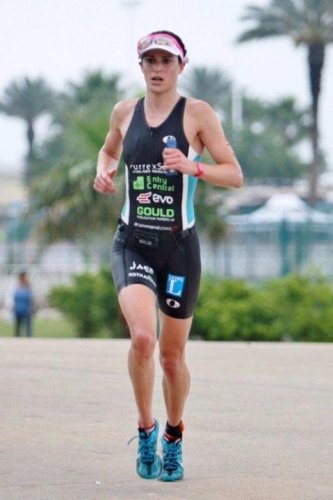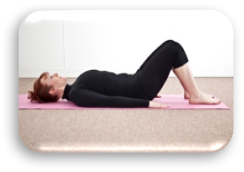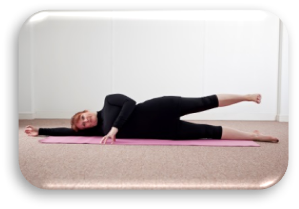Article for Clieints: By Gibwa Cole B.Sc. Chartered Physiotherapist & Clinical Pilates Specialist
 How can Pilates help my running?
How can Pilates help my running?
Most of the time, when you mention the word ‘Pilates’, it conjures images of housewives bedecked in their colourful active wear, lying on the floor and seemingly doing absolutely nothing. However, just because all appears calm externally, doesn’t mean nothing is happening below the surface. With a few marathons coming up we’re all stuck into our training programmes (hopefully) and generally giving our bodies a right good beating. The problem comes in when, if we’re not moving correctly whilst running, certain muscles start to take more of a beating and this can lead to injury. But where does Pilates come into this?
We all associate the word “core” with Pilates and it’s true. One of the big benefits associated with Pilates is the strengthening of the deep abdominal and back muscles which assist in spinal stabilisation and enable the body to move from a more stable and powerful base. In running, if your core (and here we’re also talking about the large muscles of the back, shoulders and hips) is strong and absorbing that force as your foot hits the tarmac, firstly the arms and legs won’t have to work so hard, and secondly they won’t take so much of a beating, decreasing your risk of injury.
Our core also feeds into our posture, which is so important in running. If you’re running, the way you carry yourself or how your body is aligned will influence what structures are exposed to the most stress. Often poor posture is associated with a weak core so it makes sense that if we can strengthen those core muscles we can influence posture, and by influencing posture and alignment we can start to move more efficiently in our running. This will also influence our stamina. Weak muscles will not want to keep working for 20miles. Stronger muscles will be able to maintain that alignment and spinal stabilisation for however long you need them to.
The exercises in Pilates also target things like flexibility, balance, joint mobility and breathing. Any deficits in these areas will affect your running performance and, by correcting these aspects, Pilates can help you run with more stability, increase your oxygenation by improving the way your diaphragm works, improve your body awareness which will help with technique, and decrease the stress on the muscles and joints of the body.
But where do we start? Because we all have different issues it may be useful to book in a few one-to-one Pilates Therapy sessions with a qualified Pilates Therapist who will be able to indentify your specific movement restrictions and tailor a programme to address them. Once you’re comfortable with the jargon and basics, you can then don your active wear and join the multitudes in a group class. However, in the meantime here are a few exercises that may come in handy:
- Shoulder bridge
 Starting position:
Starting position:
Lie on your back with both knees bent, feet hip distance apart and resting on the floor. Your spine and pelvis should be in a neutral position. Gently brace your abdominals, slightly open your chest as you draw the shoulder blades down the back. Gently tuck your chin in.
Instruction:
Slowly peel your spine off the floor and lift your buttocks into a bridge position. Lift one leg as you point it to the ceiling. Keep the knee straight. Inhale as you bring that leg down to the floor tapping the heel onto the mat. Exhale as you lift the leg back up to the ceiling. Try not to let the hips drop. The only thing that should move is your leg. Do this 6-10 times. Lower the foot back down to the floor and slowly ‘peel’ your spine back onto the mat. Repeat on the other side.
Modification:
The exercise can be made easier by keeping the knee of the moving leg bent as you tap the floor and lift the leg to the ceiling.
Benefits:
- Opening the hips and providing a dynamic stretch to the hip flexors which often become tight in running
- Strengthening of the large gluteal muscles which contribute to pelvic and hip stability
- Strengthening of the abdominal muscles which will feed into the core
- Improvement of spinal mobility/articulation as the back is peeled off and onto the floor
- Side leg lift
 Starting position:
Starting position:
Lie on your side with your arm supporting your head. Legs should be straight so the shoulders, hips, knees and ankle are in line. The top hand rests on the floor in front of you.
Instruction:
Lift the top leg slightly so it hovers just above the other leg. Inhale as you lift the top leg up to the ceiling (toes facing forward). Perform 3 pulses of the leg in this position. Inhale as you lower the leg back down to hover just above the other leg. Do this 8-15 times. Repeat on the other side. Try to keep the hips stacked on top of each other i.e. don’t let the top hip roll forward or back.
Modification:
For increased stability the bottom leg can be bent forward slightly.
Benefits:
- Activation and strengthening of the hip abductors which are integral to hip stability in running
- Strengthening of the obliques and side trunk stabilizers
- Enhanced trunk and pelvic stability
- Side leg drops
 Starting position:
Starting position:
Lie on your back with both legs pointing up to the ceiling at 90 degrees. You can add the 100 crunch up position to this exercise or keep the head on the floor. Squeeze the legs lightly together. Take the arms out to the sides and rest them on the floor at shoulder level, palms up.
Instruction:
Inhale as you slowly drop the legs towards the floor while keeping both shoulders on the mat. Exhale as you bring the legs back to centre. Repeat on the other side. Do this 6-10 times. The emphasis is not on getting the legs as close to the floor as possible, but rather on keeping the movement controlled and the abdominals engaged. Try to keep the low back from arching.
Modification:
The same movement can be done with knees bent.
Benefits:
- Improvement of spinal and pelvic mobility especially in a rotational direction – an underrated but necessary movement in running
- Strengthening of the abdominal muscles, especially the obliques
- Enhanced stability of the torso
Share this article with your running clients. If you are interested in learning more why not join us on our Pilates Therapy course.
